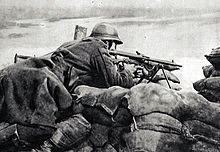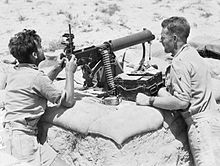Polish arms sales to Republican Spain
Since Poland was bound by non-intervention obligations, Polish governmental officials and the military disguised sales as commercial transactions mediated by international brokers and targeting customers in various countries, principally in Latin America; there are 54 shipments from Danzig and Gdynia identified.
Polish sales amounted to $40m and constituted some 5-7% of overall Republican military spendings, though in terms of quantity certain categories of weaponry, like machine-guns, might have accounted for 50% of all arms delivered.
When France embarked on the non-intervention policy towards the Spanish Civil War, Poland soon followed suit,[10] though in some specific and usually minor issues the Polish diplomacy might have sided with Italy, considered a rather friendly country.
[11] In general terms Poland calculated that co-operation between Britain, France, Italy and Germany in enforcement of non-intervention was highly desirable, since it worked towards political stability on the continent.
[12] No specific potential political gains to be achieved in Spain have been identified by the Poles and it has been decided that in principle, Warsaw should stick to neutrality and refrain from supporting any of the warring sides.
In terms of problems the Poles were gradually getting concerned about the growing Soviet influence in Spain, which triggered some anti-Soviet Polish votes at the Non-Intervention Committee.
[20] Since October 1936 the former second secretary of Spanish diplomatic representation in Budapest[21] started to act as unofficial Nationalists’ representative in Warsaw; he had access to lower-level officials of Ministry of Foreign Affairs[22] and enjoyed increasingly favorable treatment.
[29] On August 13 colonel Alfredo de Sanjuán arrived in Warsaw seeking massive arms purchases;[30] it is unclear whether he represented the Catalan autonomous government or the general staff.
[31] Sanjuán suggested to SEPEWE that in view of French declarations, transaction be organised as fictitious sales to Uruguay, but for unclear reason his mission produced no results.
[32] Another aviator, colonel Luis Riaño Herrero,[33] arrived in Warsaw on August 18 as official envoy of the Giral government; he requested sales of aircraft, but SEPEWE turned him down.
[34] There is no confirmed information on further direct Spanish-Polish talks[35] and mechanics of the Polish decision-making process, which was taking place in late August 1936, is not reconstructed.
[39] None of the sources consulted clarifies the mechanics of financial settlements between the Spanish government and the companies acting as brokers, especially whether payments were made in advance or on delivery.
[40] Their partner in Poland was SEPEWE, and mostly its deputy director Kazimierz Zarębski;[41] he operated with much autonomy, though the syndicate co-ordinated its dealings with the Polish military and the MFA.
Some dealings were executed beyond SEPEWE with smaller Polish traders, e.g. a London-based entrepreneur Stefan Czarnecki[43] set up Towarzystwo dla Handlu i Przemysłu Surowcowego and even became the honorary consul of Nicaragua, a move which facilitated his arms trade with both the Nationalists and the Republicans.
Official documentation confirming orders from representatives of fake target countries was obtained by brokers, usually by means of corruption – especially that also honorary consuls were entitled to issue certificates[50] – or forgery.
[56] There is no complete and reliable information on arms sold by Poland; official Polish documentation was partially lost during World War Two and detailed data is reconstructed on basis of fragmentary archives, Nationalist intelligence reports, private accounts and some Spanish republican papers.
30, Lewis LMG, Maxim-Spandau, Polish-designed PWU, Schwarzlose, Vickers),[59] 200,000 rifles (Enfield .303, Mauser 29, 88 and 98, Mannlicher 88/80, 90 and 95, Mosin-Nagant, Lebel 8 mm, Berthier 07/15 and 16 and other),[60] 1,5m hand grenades (mostly Polish-made wz.
It is noted that technical incompetence in militia-dominated Republican troops combined with corruption,[70] poor logistics and makeshift maintenance services often prevented effective usage of arms, and that the Nationalists extensively used seized and aged Polish imports, like the Chauchat submachine guns.
[82] Eventually the foreign minister Beck concluded that further sales to the Republic would irreparably damage future relations with the Franco regime and in the summer of 1938 he demanded from SEPEWE that the supplies be terminated.
[83] Exact decision-making process has not been reconstructed, but it seems that the military enjoyed more weight than MFA; sales continued and the last ship departed Gdynia 7 days prior to Polish de iure recognition of Nationalist Spain.
For some types of equipment like artillery pieces[87] or rifles[88] the ratio was closer to 50%, for some (machine guns) equal,[89] and for some – like hand grenades[90] or explosives[91] – the Polish deliveries exceeded the Soviet ones.
For the Polish military the supplies to Spain proved an excellent deal, as with some exceptions, the army cleared its warehouses of unwanted hardware and sold it at prices appropriate rather for modern weapons.
[98] Sales of weaponry freshly off production lines had minor adverse effect on deliveries to the Polish army, which still badly needed further re-armament into newer equipment.
[100] For SEPEWE, a syndicate which before 1936 struggled to sell arms and targeted underdeveloped countries like Romania or Turkey, sales to Republican Spain was excellent business.
[108] For the Republic Poland turned either the second[109] or the third[110] largest arms supplier; until today it is not clear what was the size of French exports, though given France was the principal architect of non-intervention policy it is unlikely that its sales exceeded the Polish ones.
In a grand exposition of arms seized from the Republicans, organized in Gran Kursaal in San Sebastián, the Polish section included 18 types of armament.
[120] In the Republican zone information on Polish arms sales was missing, not clear whether resulting from secrecy in order not to endanger breach of non-intervention agreement.
Repeated Nationalist protests did not translate into tension between Francoist Spain and Poland, and during 6 months between April and September 1939 mutual relations remained very good if not excellent; despite Nazi pressure, the Polish legation in Madrid was closed fairly late and permitted to operate unofficially, while after World War Two the Franco administration maintained official diplomatic relations with the Polish government-in-exile.
[128] After the fall of Soviet rule the subject earned few articles[129] and was extensively treated in two major works,[130] but in general the episode remains unknown to the wide public.














